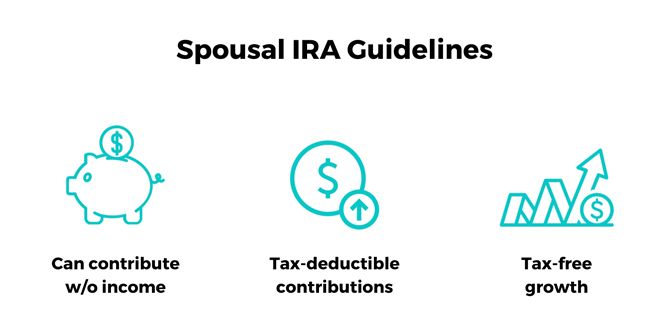Time to Read: 4 Minutes
If you and your spouse both have access to an employer-sponsored 401(k) plan, retirement saving is as easy as specifying the pre-tax contribution amount to be deducted from your paycheck. But for many couples, it’s a little more complicated. The decision may be for one spouse to leave full-time work for a period of time to care for children or parents. Or one spouse may have started a new business that currently doesn’t generate any income.
Lack of an income doesn’t have to mean neglecting tax-advantaged retirement. The IRS has created an exception to the rule that an individual must have earned income to make IRA contributions. It’s called a Spousal IRA.
Contributing regularly can keep retirement savings on track and provide access to tax-free investment growth. If you set up a Traditional IRA, the contribution may be tax-deductible and can lower your tax burden.

The Rules of the Spousal IRA
The spousal IRA is a regular IRA account and can be set up as either a Traditional IRA or a Roth IRA. It is an individual account held in the name of the spouse. To be able to open one, taxes must be filed as “married filing jointly.” The maximum contribution amount is the same for 2021– $6,000, with an additional $1,000 catch-up for those age 50 and above.
If you set up a Traditional IRA and plan to take a deduction, there are some income limits to be aware of. The full amount is deductible if the working spouse is not covered by an employer’s retirement plan. The deductible phases out according to income level when the working spouse does have an employer sponsored plan. For 2021, if income is $105,000 or less, the full amount is deductible. A partial deduction may be taken if income is more than $105,000 but less than $125,000,. At $125,000+ the contribution is not deductible. The income levels have been adjusted upwards for 2022. The full amount is deductible if income is $109,000 or less. A partial amount may be deducted if income is more than $109,000 but less than $129,000. At $129,000+ none of the contribution is deductible.
Taking Withdrawals and Distributions
The spousal IRA follows the same withdrawal rules – you need to be age 59 ½ to take money out, or you could be subject to a 10% early withdrawal penalty. And required minimum distributions will also need to be taken out of the account beginning at age 72.
If part of your retirement plan is to convert Traditional IRAs to Roth IRAs, you’ll need to do some careful planning. Taxes will be due on the amount withdrawn, potentially creating a significant tax burden in the year(s) of the conversion. The Roth conversion may reduce or eliminate RMDs in the future, allow the account to remain invested, and simplify estate planning.
Security For a Longer Retirement
Contributing to a spousal IRA can add up considerably if done consistently, which will increase the total amount of retirement savings. Depending on income levels, it can provide an additional tax deduction or, if non-deductible, can serve as a great outlet for a “backdoor Roth” savings strategy to build up tax-free assets for retirement.

